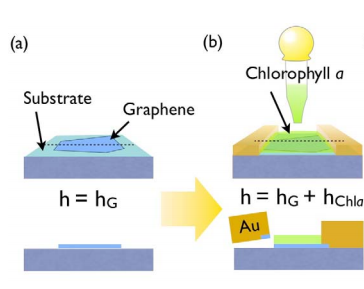Materials Scientists Build Chlorophyll-Based Phototransistor

Chlorophyll is one of the most efficient light-absorbing materials known to science. It also happens to be remarkably stable and abundant beyond imagination.
Researchers studying ways to capture and exploit photons view the amazing capabilities of chlorophyll with green-eyed wonder. Indeed, they would dearly love to copy this extraordinary light-gathering ability.
But despite decades of research, artificial light-gathering systems are no match for their chlorophyll-based competitors. Not by any means.
But there may be a quick way of catching up. Instead of designing and making artificial materials that attempt to copy chlorophyll, researchers have begun to think about using this naturally-occurring material itself and attempting to bend it to their will.
Today, Shao-Yu Chen at the Institute of Atomic and Molecular Sciences in Taiwan and a few buddies reveal how they have incorporated chlorophyll into graphene transistors to make light-activated switches.
The new phototransistor design is relatively simple. It consists of two gold electrodes connected by a sheet of graphene. The graphene is then covered by a layer of chlorophyll using a method known as drop casting. This involves placing a drop of liquid containing chlorophyll on top of the graphene and letting it evaporate. This coats the graphene with a layer of chlorophyll.
This layer has a significant influence on the electronic characteristics of the device. When a voltage is set up between the gold electrodes, relatively little current flows. However, when the chlorophyll is zapped by light of certain frequencies, the current increases dramatically.
That’s because the light causes chlorophyll to release electrons into the graphene and this increases the current that flows. In fact, Shao-Yu and co say that every photon that the chlorophyll absorbs increases the current by about a million electrons.
That’s an interesting proof-of-principle device showing that chlorophyll can be incorporated into a graphene phototransistor relatively easily .
But this is still a crude device that will need significant optimisation before it might find any kind of real world application. Indeed, a crucial question is whether there are better ways to make graphene-based devices sensitive to light, for example with quantum dots or with other light-sensitive molecules.
What will drive the interest of materials scientists is the fantastic light-gathering capabilities of natural systems based on chlorophyll. Clearly, there is enormous potential here, if only they can find a way to unlock it.
Ref: arxiv.org/abs/1306.3015: Biologically Inspired Graphene-Chlorophyll Phototransistors With High Gain
Keep Reading
Most Popular
Large language models can do jaw-dropping things. But nobody knows exactly why.
And that's a problem. Figuring it out is one of the biggest scientific puzzles of our time and a crucial step towards controlling more powerful future models.
The problem with plug-in hybrids? Their drivers.
Plug-in hybrids are often sold as a transition to EVs, but new data from Europe shows we’re still underestimating the emissions they produce.
Google DeepMind’s new generative model makes Super Mario–like games from scratch
Genie learns how to control games by watching hours and hours of video. It could help train next-gen robots too.
How scientists traced a mysterious covid case back to six toilets
When wastewater surveillance turns into a hunt for a single infected individual, the ethics get tricky.
Stay connected
Get the latest updates from
MIT Technology Review
Discover special offers, top stories, upcoming events, and more.